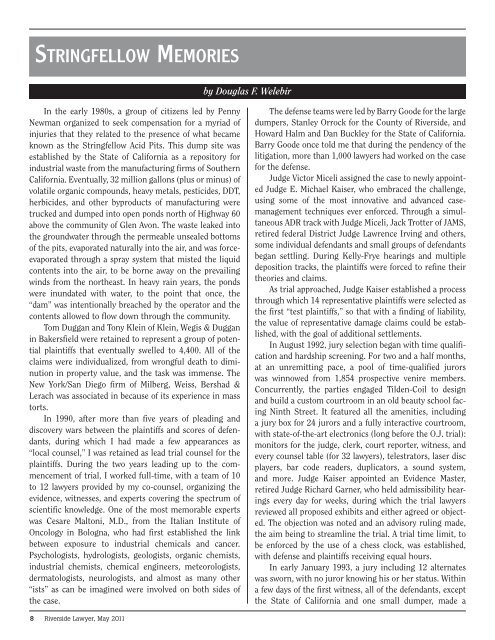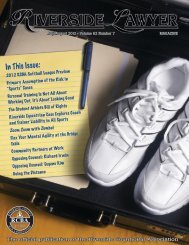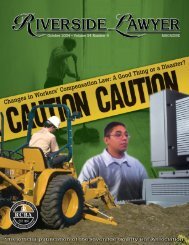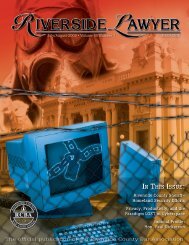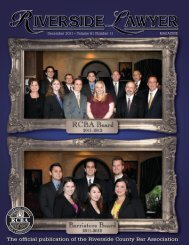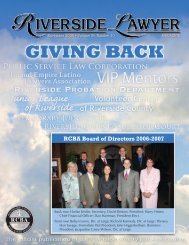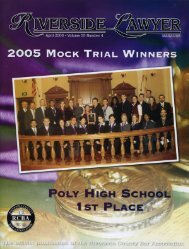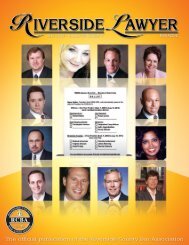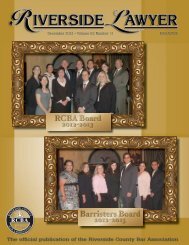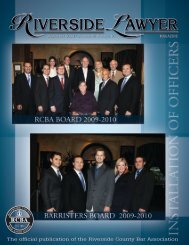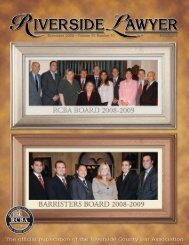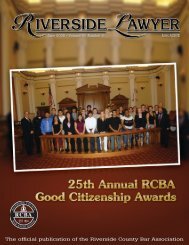In This Issue: - Riverside County Bar Association
In This Issue: - Riverside County Bar Association
In This Issue: - Riverside County Bar Association
Create successful ePaper yourself
Turn your PDF publications into a flip-book with our unique Google optimized e-Paper software.
Stringfellow Memories<br />
by Douglas F. Welebir<br />
<strong>In</strong> the early 1980s, a group of citizens led by Penny<br />
Newman organized to seek compensation for a myriad of<br />
injuries that they related to the presence of what became<br />
known as the Stringfellow Acid Pits. <strong>This</strong> dump site was<br />
established by the State of California as a repository for<br />
industrial waste from the manufacturing firms of Southern<br />
California. Eventually, 32 million gallons (plus or minus) of<br />
volatile organic compounds, heavy metals, pesticides, DDT,<br />
herbicides, and other byproducts of manufacturing were<br />
trucked and dumped into open ponds north of Highway 60<br />
above the community of Glen Avon. The waste leaked into<br />
the groundwater through the permeable unsealed bottoms<br />
of the pits, evaporated naturally into the air, and was forceevaporated<br />
through a spray system that misted the liquid<br />
contents into the air, to be borne away on the prevailing<br />
winds from the northeast. <strong>In</strong> heavy rain years, the ponds<br />
were inundated with water, to the point that once, the<br />
“dam” was intentionally breached by the operator and the<br />
contents allowed to flow down through the community.<br />
Tom Duggan and Tony Klein of Klein, Wegis & Duggan<br />
in Bakersfield were retained to represent a group of potential<br />
plaintiffs that eventually swelled to 4,400. All of the<br />
claims were individualized, from wrongful death to diminution<br />
in property value, and the task was immense. The<br />
New York/San Diego firm of Milberg, Weiss, Bershad &<br />
Lerach was associated in because of its experience in mass<br />
torts.<br />
<strong>In</strong> 1990, after more than five years of pleading and<br />
discovery wars between the plaintiffs and scores of defendants,<br />
during which I had made a few appearances as<br />
“local counsel,” I was retained as lead trial counsel for the<br />
plaintiffs. During the two years leading up to the commencement<br />
of trial, I worked full-time, with a team of 10<br />
to 12 lawyers provided by my co-counsel, organizing the<br />
evidence, witnesses, and experts covering the spectrum of<br />
scientific knowledge. One of the most memorable experts<br />
was Cesare Maltoni, M.D., from the Italian <strong>In</strong>stitute of<br />
Oncology in Bologna, who had first established the link<br />
between exposure to industrial chemicals and cancer.<br />
Psychologists, hydrologists, geologists, organic chemists,<br />
industrial chemists, chemical engineers, meteorologists,<br />
dermatologists, neurologists, and almost as many other<br />
“ists” as can be imagined were involved on both sides of<br />
the case.<br />
The defense teams were led by <strong>Bar</strong>ry Goode for the large<br />
dumpers, Stanley Orrock for the <strong>County</strong> of <strong>Riverside</strong>, and<br />
Howard Halm and Dan Buckley for the State of California.<br />
<strong>Bar</strong>ry Goode once told me that during the pendency of the<br />
litigation, more than 1,000 lawyers had worked on the case<br />
for the defense.<br />
Judge Victor Miceli assigned the case to newly appointed<br />
Judge E. Michael Kaiser, who embraced the challenge,<br />
using some of the most innovative and advanced casemanagement<br />
techniques ever enforced. Through a simultaneous<br />
ADR track with Judge Miceli, Jack Trotter of JAMS,<br />
retired federal District Judge Lawrence Irving and others,<br />
some individual defendants and small groups of defendants<br />
began settling. During Kelly-Frye hearings and multiple<br />
deposition tracks, the plaintiffs were forced to refine their<br />
theories and claims.<br />
As trial approached, Judge Kaiser established a process<br />
through which 14 representative plaintiffs were selected as<br />
the first “test plaintiffs,” so that with a finding of liability,<br />
the value of representative damage claims could be established,<br />
with the goal of additional settlements.<br />
<strong>In</strong> August 1992, jury selection began with time qualification<br />
and hardship screening. For two and a half months,<br />
at an unremitting pace, a pool of time-qualified jurors<br />
was winnowed from 1,854 prospective venire members.<br />
Concurrently, the parties engaged Tilden-Coil to design<br />
and build a custom courtroom in an old beauty school facing<br />
Ninth Street. It featured all the amenities, including<br />
a jury box for 24 jurors and a fully interactive courtroom,<br />
with state-of-the-art electronics (long before the O.J. trial):<br />
monitors for the judge, clerk, court reporter, witness, and<br />
every counsel table (for 32 lawyers), telestrators, laser disc<br />
players, bar code readers, duplicators, a sound system,<br />
and more. Judge Kaiser appointed an Evidence Master,<br />
retired Judge Richard Garner, who held admissibility hearings<br />
every day for weeks, during which the trial lawyers<br />
reviewed all proposed exhibits and either agreed or objected.<br />
The objection was noted and an advisory ruling made,<br />
the aim being to streamline the trial. A trial time limit, to<br />
be enforced by the use of a chess clock, was established,<br />
with defense and plaintiffs receiving equal hours.<br />
<strong>In</strong> early January 1993, a jury including 12 alternates<br />
was sworn, with no juror knowing his or her status. Within<br />
a few days of the first witness, all of the defendants, except<br />
the State of California and one small dumper, made a<br />
8 <strong>Riverside</strong> Lawyer, May 2011


